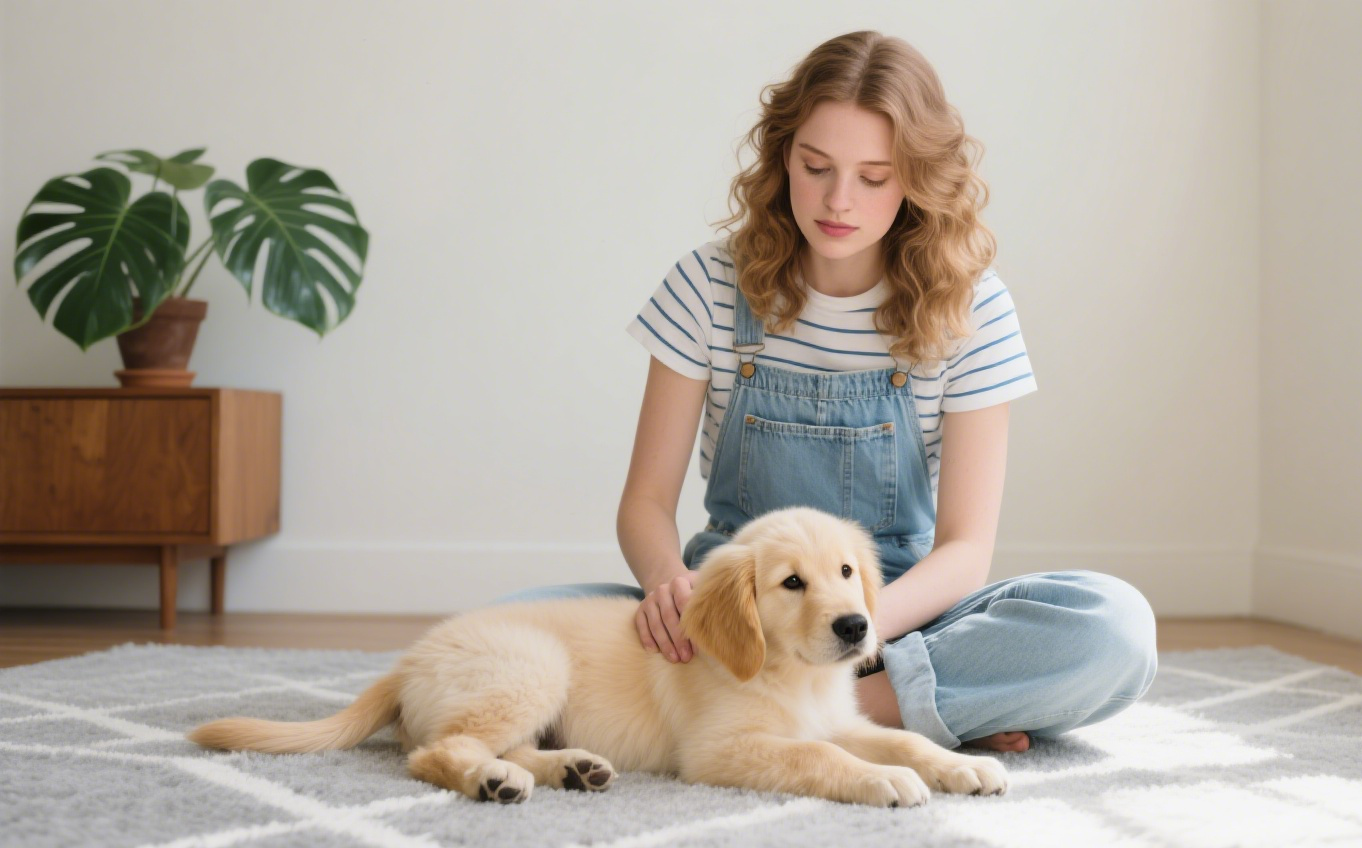Hello
Puppies learn best in short, happy bursts. With a realistic schedule you can build rock-solid habits—potty, crate, chewing, recall, leash manners—without overwhelm. This age-by-age routine is vet/trainer-approved and rooted in positive reinforcement and clear management. Use it as your daily map and adjust for breed, energy, and your household rhythm.
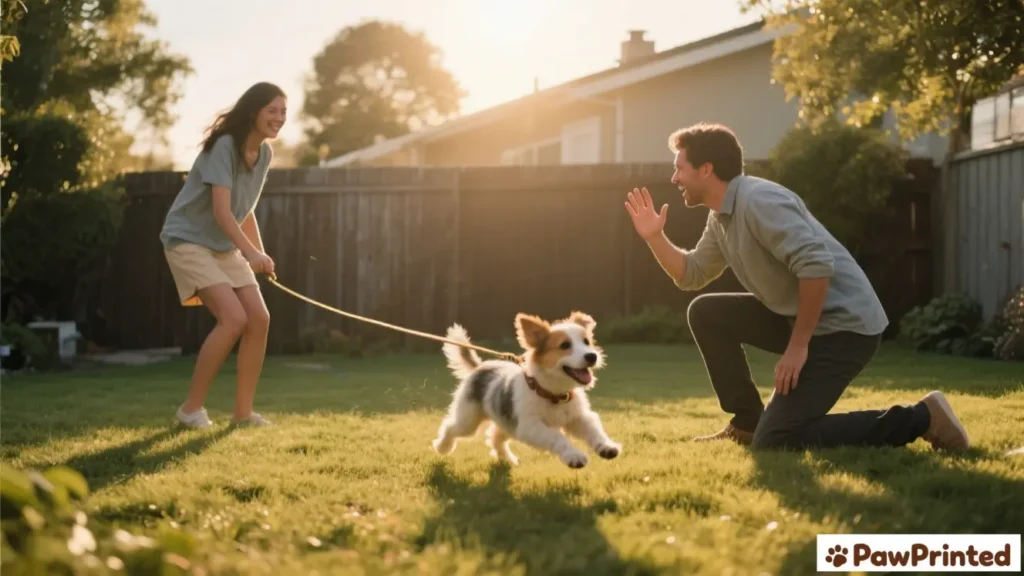
What You’ll Need (Training Tools)
| Tool | Use | Why it helps |
|---|---|---|
| Soft pea-sized treats | Rewards | High value and fast to eat for rapid reps |
| Clicker or marker word “Yes!” | Timing | Marks the exact moment your puppy is right |
| 4–6 ft leash + flat collar/harness | Leash work | Prevents pulling from being reinforced |
| Crate or playpen | Naps, alone-time, potty rhythm | Stops rehearsal of unwanted behavior |
| Kong/lick mat/long chew | Calm enrichment | Reduces biting and builds independence |
| Poop bags + enzymatic cleaner | Potty habit | Removes scent to avoid repeat accidents |
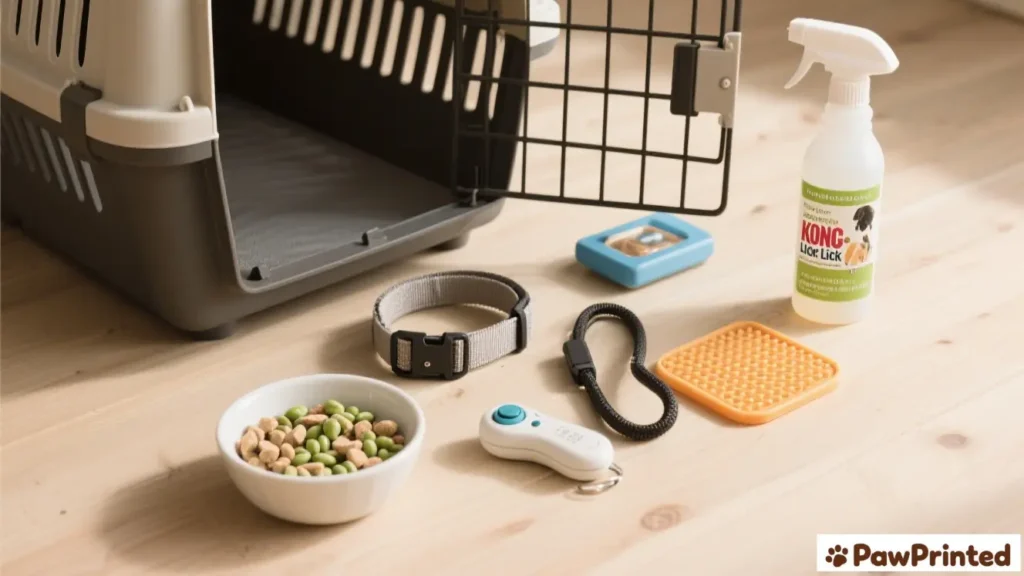
Step-by-Step Training Guide (Core Skills You’ll Touch Every Day)
- Name & Check-In: Say the name → pup glances at you → mark (“Yes!”) → treat. 1–2 minutes, several times daily.
- Potty Rhythm: Outside after sleep, play, meals, and excitement. Go to the same spot. When finished, soft praise, then reward.
- Bite Inhibition & Trade: Offer a long chew. If teeth touch skin/clothes, calmly redirect or trade: present treat, pup releases item, mark, then give the chew back.
- Crate = Calm: Toss a treat in, pup enters, mark and reward. Short door-closed moments with a stuffed Kong. Open before fuss escalates.
- Leash Foundations Indoors: Reward for a slack leash and staying near your side. Keep sessions 1–3 minutes.
- Sit/Down/Stay (Micro-Reps): 3–5 reps at a time. Quit while your puppy still wants more.
- Recall Games: Two-person ping-pong recalls or hide-and-seek. Say “Come!” once, mark the turn, jackpot on arrival.
- Handling & Grooming: Touch ears/paws, brush, clipper noise → treat. Build lifelong vet/groomer comfort.
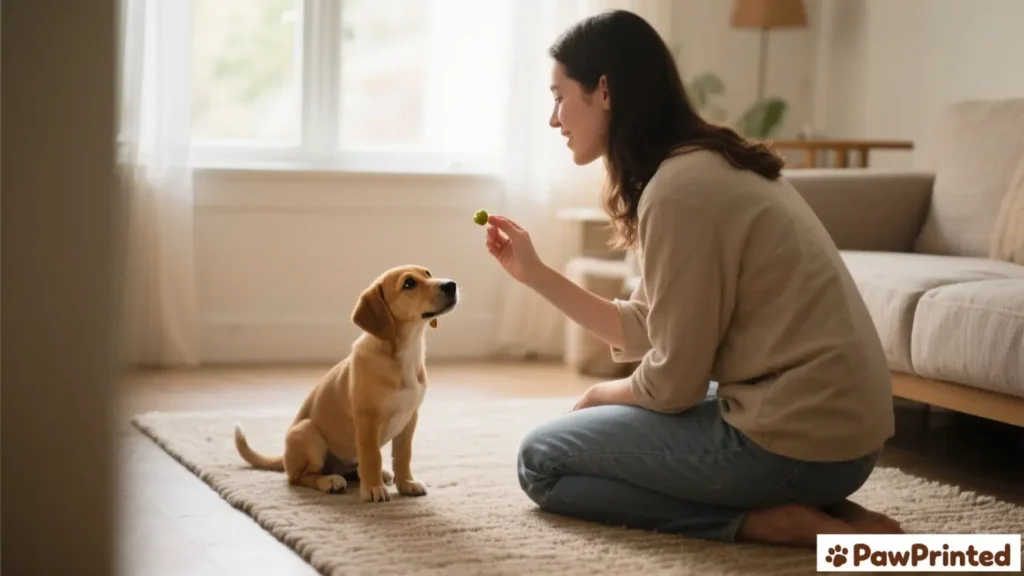
Why This Works (Behavior Science)
- Behavior that gets reinforced repeats.
- Classical conditioning makes your name/marker/recall cue predict great things.
- Short, easy wins prevent frustration and build momentum.
- Management (crate/pen/leash) stops bad habits from being practiced.

Age-by-Age Daily Schedules
8 Weeks (2 months) — Set the Rhythm
- Potty: every 45–60 minutes while awake + after sleep/play/meals.
- Awake window: 60–90 minutes, then a nap.
- Training: 4–6 micro-sessions/day (1–2 minutes each).
Sample: 7:00 wake & potty → breakfast → 2 min name/hand target → calm play → 8:00 nap. 9:00 potty → 2 min sit → chew/Kong → 10:00 nap. 12:00 potty → lunch → 2 min crate games → nap. 15:00 potty → 2 min recall → nap. 18:00 potty → dinner → 2 min leash indoors → nap. 21:00 potty → quiet chew → overnight sleep with one late-night potty as needed.
10–12 Weeks — Socialize the World
- Potty: every 60–90 minutes awake.
- Socialization: daily new sights, sounds, surfaces, people—pair with treats.
- Training: 6–8 micro-sessions (1–3 minutes).
- Add: gentle handling, short car rides, sound desensitization.
3–4 Months — Skills Stick
- Potty: every 90–120 minutes awake.
- Leash: short outdoor walks if vaccinated; pay generously for a slack leash.
- Stay/Place: 5–10 seconds on a mat with frequent rewards.
- Recall: long-line outdoors; jackpot fast sprints to you.
5–6 Months — Teen Brain Incoming
- Potty: every 2–3 hours; accidents may spike—stay consistent.
- Impulse control: add easy distractions to sit/down/stay.
- Leash: change direction before pulling works; reward check-ins.
- Alone-time: 5 → 20 minutes with stuffed Kong to prevent separation issues.
7–9 Months — Proof & Generalize
- Practice everywhere: home, street corners, pet-friendly stores.
- Cue once; if ignored, make it easier, then rebuild.
- Increase mental work: nose games, shaping, trick training.
10–12 Months — Young Adult Habits
- Fewer naps; longer walks (age-appropriate).
- Shift to variable rewards (sometimes treat, sometimes praise/play).
- Run a weekly “review” of recall, leash, settle.
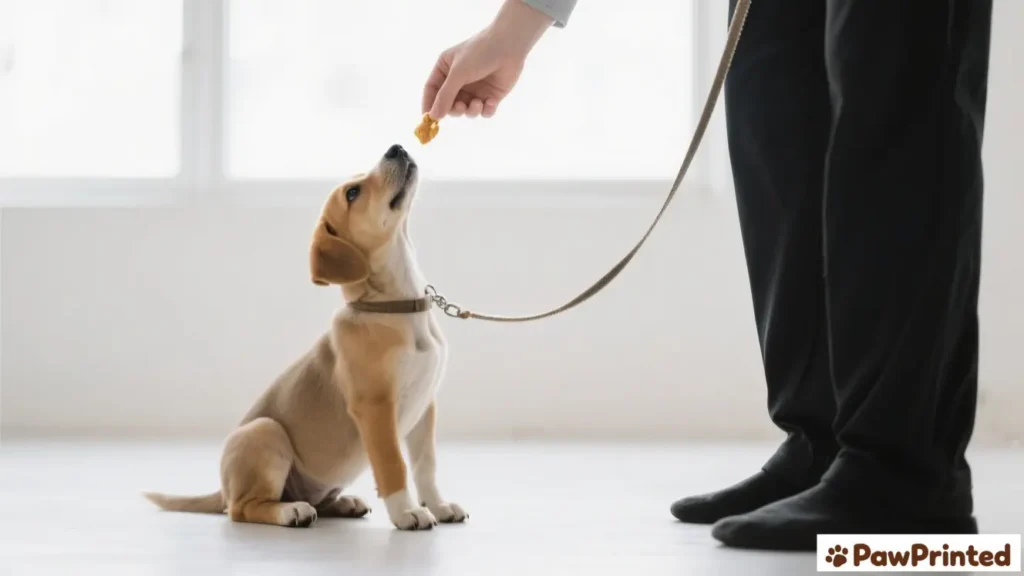
How Long It Takes (Timeline & Expectations)
- Potty rhythm: 2–4 weeks with consistency.
- Reliable name response & indoor recall: 1–2 weeks; outdoors: 4–8+ weeks.
- Loose-leash walking: ongoing—think months, not days.
- Crate comfort: 1–3 weeks of daily tiny reps.
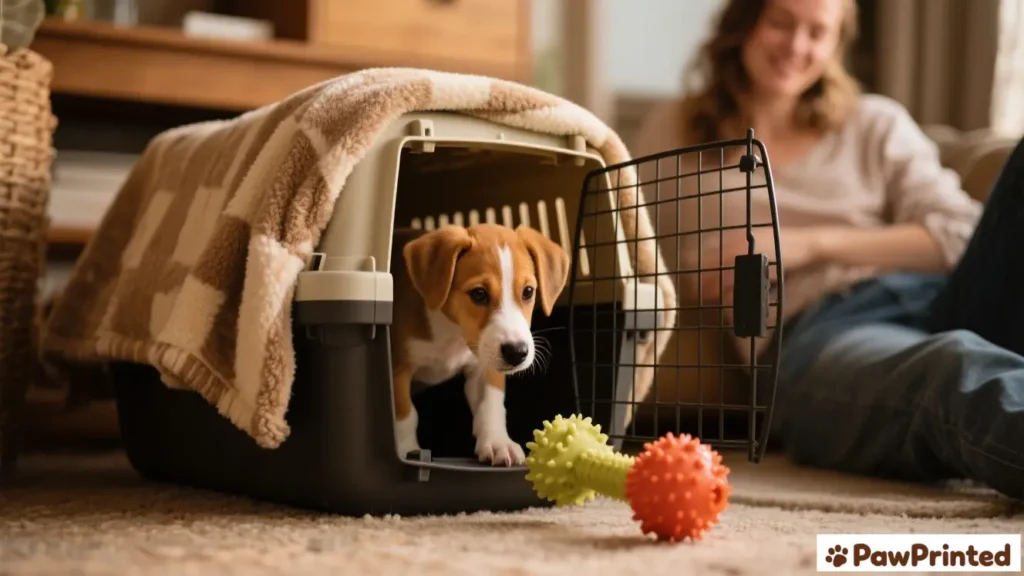
Common Mistakes to Avoid
- Sessions are too long → zoomies or shutdown. Keep them short.
- Repeating cues (“Sit sit sit…”) → cue becomes noise. Say it once.
- Punishing accidents → teaches hiding, not pottying outside. Clean and reset rhythm.
- Free roaming without management → chewing and indoor pottying get practiced.
Variations & Age Adjustments
- Toy/working breeds: need more mental work—add puzzles and trick reps.
- Giant breeds: tire faster; keep play low-impact and protect joints.
- Shy pups: go slower with socialization and pair every new thing with food.
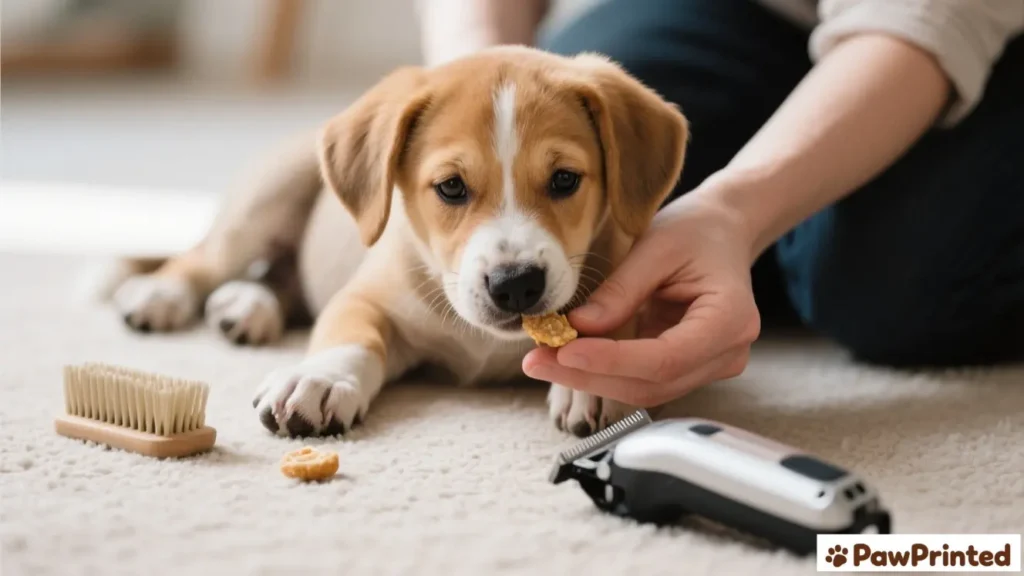
FAQ
When can I start formal training?
Day one. Keep it fun and 1–3 minutes per mini-session.
How many times should I train each day?
6–10 micro-sessions sprinkled through your routine beat one long block.
My puppy won’t take treats outside—what now?
Level up the value (chicken/cheese), start in easier spots, mark tiny successes.
Do I need nighttime potty trips?
Yes for 8–12-week pups (once or twice). Quiet trip out, no party, straight back to sleep.
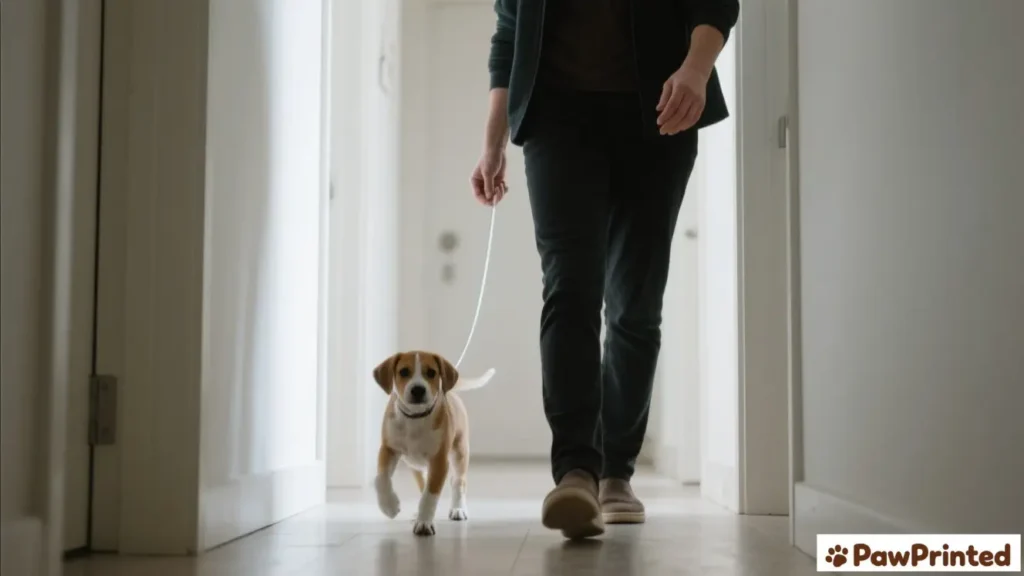
Thank You
You’ve got this! Consistency, tiny wins, and lots of reinforcement build the habits you want. If this guide helped, share it with a new-puppy friend and follow PawPrinted on Pinterest for weekly training plans.

Printable: Age-Based Puppy Training Schedule&pdf
Print what you want
- Crate or playpen
- 4–6 ft leash + harness/collar
- Treat pouch (optional)
- Kong/lick mat/long chew
- Measuring spoon for treat sizing (optional)
- Tools
- Soft pea-sized treats high value, fast to eat
- Clicker or marker word “Yes!”
- 4 –6 ft leash + flat collar/harness
- Crate or playpen
- Kong / lick mat / long chew
- Poop bags + enzymatic cleaner
- Daily Highlights by Age quick reference
- 8 weeks: potty every 45–60 min awake; 4–6 × 1–2 min training bursts; many naps.
- 10 –12 weeks: potty every 60–90 min; 6–8 micro-sessions 1–3 min; daily socialization (pair with food).
- 3 –4 months: potty every 90–120 min; begin short outdoor leash work vaccines permitting; 5–10 s mat/settle.
- 5 –6 months: potty every 2–3 hrs; add light distractions; alone-time 5→20 min with stuffed Kong.
- 7 –9 months: generalize cues in new places; nose games/shaping/tricks.
- 10 –12 months: longer age-appropriate walks; variable rewards; weekly review block.
- Core Daily Steps (do these every day)
- Name & Check-In — Say the name → eye contact → mark (“Yes!”) → treat; 1–2 minutes, several times/day.
- Potty Rhythm — Outside after sleep, play, meals, excitement; same spot; reward calmly after finishing.
- Bite Inhibition & Trade — Provide long chew; if teeth touch skin/clothes, redirect or trade (present treat → release → mark → return chew).
- Crate = Calm — Toss treat in, pup enters, mark/reward; short door-closed moments with stuffed Kong; open before fuss escalates.
- Leash Foundations Indoors — Pay generously for slack leash and position near your side; 1–3 minute mini-sessions.
- Sit/Down/Stay (Micro-Reps) — 3–5 reps at a time; quit while your puppy still wants more.
- Recall Games — Two-person ping-pong recalls or hide-and-seek; cue once, mark the turn toward you, jackpot on arrival.
- Handling & Grooming — Touch ears/paws, brief brush/clipper noise → treat; build vet/groomer comfort.
- Age-Based Schedule (expand as needed)
- 8 Weeks (2 months) — Set the Rhythm
- Potty: every 45–60 minutes while awake + after sleep/play/meals.
- Awake window: 60–90 minutes, then nap.
- Training: 4–6 micro-sessions/day (1–2 minutes each).
- Sample cycle: wake & potty → breakfast → 2 min name/target → play → nap; repeat through the day; quiet late-night potty as needed.
- 10–12 Weeks — Socialize the World
- Potty: every 60–90 minutes.
- Socialization: daily new sights/sounds/surfaces/people paired with treats.
- Training: 6–8 micro-sessions (1–3 minutes).
- Add: gentle handling, short car rides, sound desensitization.
- 3–4 Months — Skills Stick
- Potty: every 90–120 minutes.
- Leash: short outdoor walks if vaccinated; pay for slack leash.
- Stay/Place: 5–10 seconds calm on a mat with frequent rewards.
- Recall: long-line outdoors; jackpot fast sprints to you.
- 5–6 Months — Teen Brain Incoming
- Potty: every 2–3 hours; adolescence may spike accidents—stay consistent.
- Impulse control: add easy distractions to sit/down/stay.
- Leash: change direction before pulling works; reward check-ins.
- Alone-time: 5 → 20 minutes with stuffed Kong.
- 7–9 Months — Proof & Generalize
- Practice everywhere: home, street corners, pet-friendly stores.
- Cue once; if ignored, make it easier, then rebuild.
- Add mental work: nose games, shaping, trick training.
- 10–12 Months — Young Adult Habits
- Fewer naps; longer age-appropriate walks.
- Shift to variable rewards (sometimes treat, sometimes praise/play).
- Keep a weekly “review” of recall, leash, and settle.
• Reinforcement: pay generously for calm, check-ins, and coming when called; behavior repeated = behavior reinforced.
• Management: supervise or contain; prevent rehearsal of chewing/indoor pottying.
• Potty troubleshooting: accidents are information—tighten the rhythm and supervise; clean with enzymatic cleaner.
• Safety: adjust for breed, health, growth plates; keep play low-impact for large/giant breeds.
• Progress timeline: potty rhythm 2–4 weeks; indoor recall 1–2 weeks; outdoor recall 4–8+ weeks; loose-leash is months, not days.
• Printing: export this card or the “Daily Highlights by Age” list to PDF for a fridge-friendly checklist.

